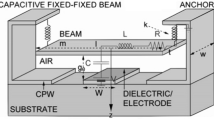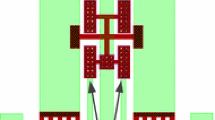Abstract
The technology for radio frequency micro-electro-mechanical system (RF MEMS) is well established. In the next phase of miniaturization, RF MEMS transforming into RF nano-electro-mechanical system (NEMS) requires scaling laws. For MEMS devices, vertical scaling laws are available in the literature. However, existing scaling laws are isotropic and not valid for the majority of the MEMS devices. Like VLSI technology, the scaling in the MEMS is asymmetric and needs optimization in each direction. In the MEMS, depending upon the working principle, the scaling laws vary from device to device. In the present work, spring constant scaling laws for the electrostatic RF MEMS devices are derived given the device performance. The scaling laws are derived in such a way that existing limitations of the MEMS technology like low switching speed, high pull-in voltage, stiction, etc., are minimized and the response of the switch is improved.








Similar content being viewed by others
References
De Groot, W.A., Webster, J.R., Felnhofer, D., Gusev, E.P.: Review of device and reliability physics of dielectrics in electrostatically driven MEMS devices. IEEE Trans. Device Mater. Reliab. 9(2), 190–202 (2009). https://doi.org/10.1109/TDMR.2009.2020565
Zaghloul, U., Piazza, G.: Highly scalable NEMS relays with stress-tuned switching voltage using piezoelectric buckling actuators. IEEE Trans. Electron Devices 61(10), 3520–3528 (2014). https://doi.org/10.1109/TED.2014.2331914
Wautelet, M.: Scaling laws in the macro, micro and nanoworlds. Eur. J. Phys. 22(6), 601–611 (2001). https://doi.org/10.1088/0143-0807/22/6/305
Trimmer, W.S.N.: Microrobots and micromechanical systems. Sensors and Actuators 19(3), 267–287 (1989). https://doi.org/10.1016/0250-6874(89)87079-9
Bansal, D., Bajpai, A., Kumar, P., Kaur, M., Kumar, A.: Effect of Stress on Pull-in Voltage of RF MEMS SPDT Switch. IEEE Trans. Electron Devices 67(5), 2147–2152 (2020). https://doi.org/10.1109/ted.2020.2982667
Bansal, D., Bajpai, A., Mehta, K., Kumar, P., Kumar, A.: Improved Design of Ohmic RF MEMS Switch for Reduced Fabrication Steps. IEEE Trans. Electron Devices 66(10), 4361–4366 (2019). https://doi.org/10.1109/TED.2019.2932846
Bansal, D., Kumar, A., Sharma, A., Kumar, P., Rangra, K.J.: Design of novel compact anti-stiction and low insertion loss RF MEMS switch. Microsyst. Technol. 20(2), 337–340 (2013). https://doi.org/10.1007/s00542-013-1812-1
Rangra, K., et al.: Symmetric toggle switch—a new type of rf MEMS switch for telecommunication applications: Design and fabrication. Sensors Actuators A Phys. 123–124, 505–514 (2005). https://doi.org/10.1016/j.sna.2005.03.035
Jindal, S.K., Magam, S.P., Shaklya, M.: Analytical modeling and simulation of MEMS piezoresistive pressure sensors with a square silicon carbide diaphragm as the primary sensing element under different loading conditions. J. Comput. Electron. 17(4), 1780–1789 (2018). https://doi.org/10.1007/s10825-018-1223-8
Varma, M.A., Jindal, S.K.: Novel design for performance enhancement of a touch-mode capacitive pressure sensor: theoretical modeling and numerical simulation. J. Comput. Electron. 17(3), 1324–1333 (2018). https://doi.org/10.1007/s10825-018-1174-0
Pu, S.H., Holmes, A.S., Yeatman, E.M., Papavassiliou, C., Lucyszyn, S.: Stable zipping RF MEMS varactors. J. Micromechanics Microengineering 20(3), 035030 (2010). https://doi.org/10.1088/0960-1317/20/3/035030
Rebeiz, G.M.: RF MEMS: Theory, Design, and Technology. John Wiley & Sons Inc, Hoboken, NJ, USA (2003)
He, X., et al.: Design and consideration of wafer level micropackaging for distributed RF MEMS phase shifters. Microsyst. Technol. 14(4–5), 575–579 (2007). https://doi.org/10.1007/s00542-007-0438-6
S. Gong, H. Shen, and N. S. Barker (2011) “A 60-GHz 2-bit switched-line phase shifter using SP4T RF-MEMS switches.” IEEE Trans Microw Theory Tech. 59(4); 894–900. doi: https://doi.org/10.1109/TMTT.2011.2112374.
Bansal, D., Bajpai, A., Kumar, P., Kumar, A., Kaur, M., Rangra, K.: Design and fabrication of a reduced stiction radio frequency MEMS switch. J. Micro/Nanolithography, MEMS, MOEMS 14(3), 035002 (2015). https://doi.org/10.1117/1.JMM.14.3.035002
Van Spengen, W.M., Puers, R., De Wolf, I.: On the physics of stiction and its impact on the reliability of microstructures. J. Adhes. Sci. Technol. 17(4), 563–582 (2003). https://doi.org/10.1163/15685610360554410
a Koszewski, F. Souchon, C. Dieppedale, D. Bloch, and T. Ouisse (2013) “Physical model of dielectric charging in MEMS.” J. Micromechanics Microengineering. 23(4); 045019. doi: https://doi.org/10.1088/0960-1317/23/4/045019.
Tas, N., Sonnenberg, T., Jansen, H., Legtenberg, R., Elwenspoek, M.: Stiction in surface micromachining. J. Micromechanics Microengineering 6(4), 385–397 (1996). https://doi.org/10.1088/0960-1317/6/4/005
S. Melle et al (2007) “Investigation of Stiction Effect in Electrostatic Actuated RF MEMS Devices.” in 2007 Topical Meeting on Silicon Monolithic Integrated Circuits in RF Systems. 21(2); 173–176, doi: https://doi.org/10.1109/SMIC.2007.322787.
Author information
Authors and Affiliations
Corresponding author
Ethics declarations
Conflict of interest
Authors declare no conflict of interest.
Additional information
Publisher's Note
Springer Nature remains neutral with regard to jurisdictional claims in published maps and institutional affiliations.
Rights and permissions
About this article
Cite this article
Bansal, D., Kumar, P. & Kumar, A. Improvement of RF MEMS devices by spring constant scaling laws. J Comput Electron 20, 1006–1011 (2021). https://doi.org/10.1007/s10825-021-01657-z
Received:
Accepted:
Published:
Issue Date:
DOI: https://doi.org/10.1007/s10825-021-01657-z




